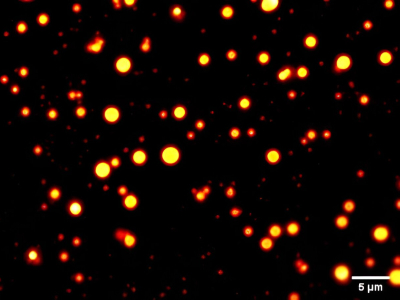
Credit: Gable Wadsworth and Priya Banerjee
Researchers have published new findings on RNA phase separation as well as the role that temperature plays in RNA molecular interactions. The findings shine a new light on cellular processes and may ultimately change the way we think about biology or biophysics.
In the study, published in Nature Chemistry, the researchers examined the role of temperature as RNA molecules undergo phase separation. During phase separation, RNA forms physically distinct condensates, specialized structures that are involved in various cell processes and in the past have been linked to various neurodegenerative disorders.
"The phase separation of biomolecules has sort of revolutionized our thinking of how cells compartmentalize processes," says Priya Banerjee, associate professor in the UB Department of Physics. "Most studies have been protein-centric, with the idea being that proteins form these liquid-like condensates, and we have been very interested in what RNA does to this process. So far, studies have been limited to examining how RNA can regulate protein phase separation, so looking at RNA in more of a regulatory role."
The researchers were intrigued by how RNA may drop out of its regulatory role and phase separate on its own. Through their research, the team discovered that RNA molecules have a lower critical solution temperature (LCST) phase behavior and that the polyphosphate also showed this same behavior where phase separation is favored at high temperatures.
"We used computations and some of our theoretical understanding of LCST phase behaviors and realized that what Banerjee and colleagues were observing was a combination of two processes," said Rohit Pappu Professor of biomedical engineering at Washington University in St. Louis. "The phosphate backbone and the solution ions dissolve with increased temperature. The loss of hydration waters from complementary halves drives RNA molecules to seek one another, and the ions bridge phosphate groups within and across different molecules to enable phase separation."
Further analysis revealed that the condensed phases become crosslinked networks and the networking afforded by strong RNA interactions can enable different behavior when either heating or cooling. The team found that a reduction in temperature leads to persistent condensates.
"RNA has this interesting thermometer, if you will, that senses temperature change," said Priya Banerjee. "This study is a new direction in how we think about phase separation of molecules in general, and could lead to a new understanding of biology, biophysics, materials science and even the origins of life."